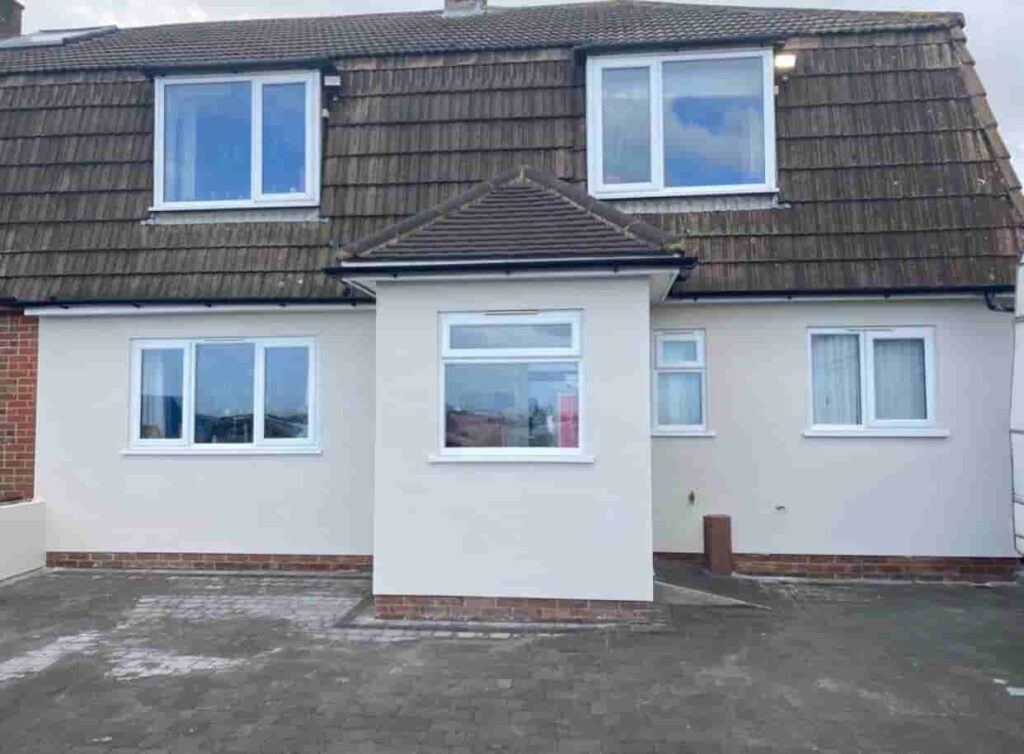Roof flashing plays an essential role in protecting your home from water ingress. It acts as a waterproof barrier where the roof meets walls, chimneys, or other structural joints, guiding rainwater away from vulnerable areas. However, even well-installed flashing can deteriorate over time. At Greenhithe Roofing Repairs, we frequently find that roof leaks in Greenhithe, Kent are caused by damaged or poorly maintained flashing.
Understanding which areas of your roof are most at risk can help you spot early warning signs and prevent costly water damage.
What Is Roof Flashing and Why Is It Important?
Flashing is typically made from lead, aluminium, copper, or galvanised steel and is installed around roof intersections or openings. Its job is simple yet crucial — to create a watertight seal where different surfaces meet.
Without properly functioning flashing, rainwater can easily seep beneath roof coverings, leading to rot, dampness, and structural decay. Over time, even minor flashing failures can allow moisture to penetrate deep into roof timbers and insulation.
Below are the seven most common areas where flashing is particularly vulnerable — and where leaks are most likely to occur.
1. Around Chimneys
Chimneys are one of the most leak-prone parts of a roof because they interrupt the roofline and require multiple layers of flashing. Typically, these include step flashing along the sides and counter flashing embedded into the brickwork.
Common causes of failure include:
- Cracked or missing mortar where flashing meets the chimney stack.
- Rust or corrosion from prolonged exposure to rain.
- Flashing separation due to temperature fluctuations or structural movement.
At Greenhithe Roofing Repairs, we often find that re-bedding or re-sealing the flashing around chimneys quickly resolves persistent leaks.
2. Roof Valleys
Valleys are formed where two roof slopes meet, creating a natural channel for rainwater. Because they handle a high volume of water flow, even a small gap or crack in the valley flashing can lead to significant leaks.
Issues in this area may arise from:
- Corrosion or rusting of metal valley liners.
- Build-up of leaves, moss, or debris blocking drainage.
- Incorrect overlap or poor sealing during installation.
Regular maintenance of valleys is essential to ensure efficient water flow and prevent early deterioration.
3. Around Roof Vents and Pipes
Any penetration through the roof surface — such as a vent, flue, or pipe — is a potential weak point. The flashing around these areas seals the gap between the structure and the roofing material, preventing rain from entering.
Over time, the sealant or flashing collar can degrade due to UV exposure or temperature changes. If you notice dampness near a vent pipe or in your loft, damaged vent flashing is often the culprit.
4. Along Skylights and Roof Windows
While skylights bring natural light into your home, they also present one of the most complex flashing challenges. Improper installation or deterioration of the flashing system around the frame can cause persistent leaks that appear around ceilings or interior walls.
Typical problems include:
- Blocked drainage channels around the skylight.
- Cracked or lifting sealant at the frame edges.
- Flashing not overlapping correctly with surrounding roof tiles.
Professional inspection ensures that skylight flashing remains watertight and continues to perform as designed.
5. At Roof Edges and Eaves
The roof’s lower edge, or eave, is constantly exposed to the elements. Flashing in this area helps prevent water from backing up under the tiles or fascia boards.
Flashing at eaves may deteriorate because of:
- Ice dams and water pooling during colder months.
- Corrosion due to prolonged water exposure.
- Wind uplift that loosens or bends the flashing metal.
Since eaves are also prone to condensation and gutter blockages, regular inspection can help prevent moisture-related issues.
6. Around Dormers and Roof Extensions
Dormer roofs and loft conversions often feature multiple joints where the roof meets vertical walls. Each of these transitions requires precision flashing to remain watertight.
Failures in dormer flashing are usually caused by:
- Improper sealing between horizontal and vertical surfaces.
- Expansion and contraction leading to cracks or separations.
- Ageing materials that have lost their flexibility.
These areas are particularly important to monitor because leaks often go unnoticed behind plasterboard or insulation until significant damage occurs.
7. Along Parapet and Upstand Walls
Flat and low-pitched roofs often feature parapet walls — short walls extending above the roof surface. Flashing is installed at their base to direct water away from the wall joint.
Over time, flashing in these areas can deteriorate due to:
- Standing water pooling against the wall base.
- Poor drainage or blocked outlets.
- Movement in the wall structure or roofing membrane.
Repairing or upgrading flashing in these areas can dramatically reduce the risk of leaks in flat or partially flat roofs.
Why Flashing Deteriorates Over Time
Even high-quality flashing materials eventually wear down. The most common reasons include:
- Weather exposure: UV radiation, wind, and temperature shifts cause metals and sealants to expand and contract.
- Oxidation and corrosion: Especially in coastal areas like Greenhithe, salt in the air accelerates metal corrosion.
- Improper installation: Flashing that’s not correctly overlapped or sealed will fail prematurely.
- Neglected maintenance: Debris build-up, moss, or loose mortar can shorten the lifespan of flashing systems.
Preventing Flashing Failures
Proactive maintenance is the best way to avoid leaks caused by flashing damage. Homeowners can take the following measures:
- Schedule regular roof inspections, especially after storms or freezing weather.
- Keep gutters, valleys, and roof surfaces free of debris.
- Check chimney mortar joints and roof junctions annually.
- Act quickly at the first sign of damp patches or internal leaks.
Greenhithe Roofing Repairs provides comprehensive inspections and professional flashing repairs across Greenhithe, Kent. Our skilled team identifies problem areas early and applies durable solutions that restore full waterproof protection to your roof.
Conclusion
Flashing may seem like a small component of your roofing system, but it plays a vital role in preventing leaks and structural damage. The areas around chimneys, valleys, skylights, and dormers are especially vulnerable, and keeping them maintained is essential for the health of your property.
Greenhithe Roofing Repairs in Greenhithe, Kent specialises in diagnosing and repairing flashing failures, ensuring your roof remains secure and watertight in every season. With professional attention and regular maintenance, you can extend the lifespan of your roof and protect your home from unwanted water damage.
Call us on: 01322 952 297
Click here to find out more about Greenhithe Roofing Repairs
Click here to complete our contact form and see how we can help with your roofing needs.

